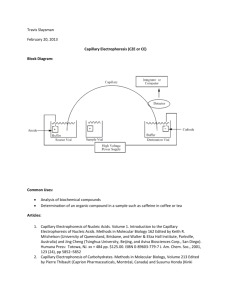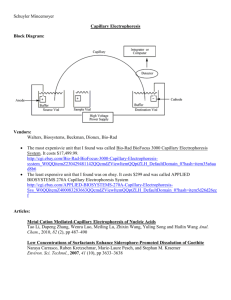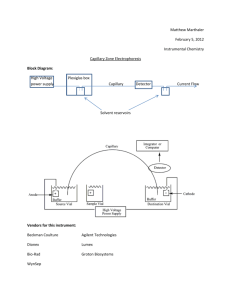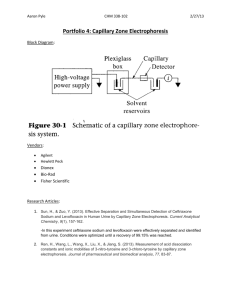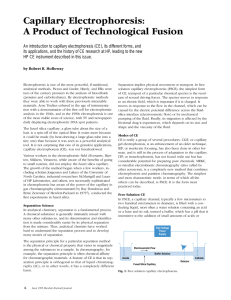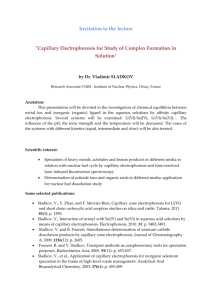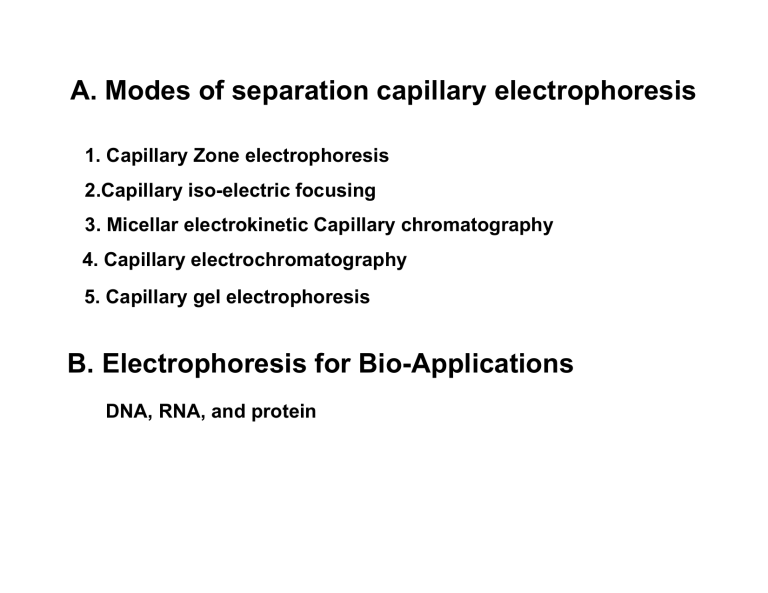
A. Modes of separation capillary electrophoresis 1. Capillary Zone electrophoresis 2.Capillary iso-electric focusing 3. Micellar electrokinetic Capillary chromatography 4. Capillary electrochromatography 5. Capillary gel electrophoresis B. Electrophoresis for Bio-Applications DNA, RNA, and protein Capillary iso-electric focusing O OH NH3 + pH pH O O NH3 + iso-electric zwitterionic In this case, the electroosmotic force is weaker than elctrophoretic force. Micellar electrokinetic Capillary chromatography Separation of neutral solute Psuedo-stationary phase Advantage: easy to apply Disadvantage: less selectivity Capillary electrochromatography Capillary electrochromatography is an electroosmotically driven liquid chromatographic technique. Stationary phase Mobile phase Capillary electrochromatography: yes yes Capillary electrophoresis: no yes Charged solutes Neutral solutes Capillary electrochromatography: yes yes Capillary electrophoresis: yes no Capillary Electrochromatography: analysis of polycyclic aromatic hydrocarbones Stationary phase: 90% 3-m octyldecyl-silica particles; 10% 1-m silica Partition stationary phase Stabilization of Electroosmotic flow Mobile phase: mixture of acetonitrile and 4mM soldium tetraborate solution R. N. Zare, et al., Anal. Chem. 1995, 67, 2026 Capillary Electrochromatography: analysis of polycyclic aromatic hydrocarbones N = 5.44 (tR/wh)2 = 16 (tR/wb)2 R. N. Zare, et al Anal. Chem. 1995, 67, 2026 5. Capillary gel electrophoresis --------------- + - + Gel --------------- - ----------------------------a. Blocking the solute diffusion caused by Joule heating b. Size of the channels in the gel gives further selection (entropy effect) B. Electrophoresis for Bio-Applications Separation of DNA, RNA, and protein Gel electrophoresis Capillary gel electrophoresis --------------- + --------------- - + - Electroosmosis can play a significant role in capillary gel electrophoretic separation, but not in gel electrophoretic separation. Both techniques separate solutes by their eletrophoretic mobility. Separation of DNA and RNA 1 L Separation of Protein Size effect and electrophoretic mobility Further applications -- an example: DNA sequencing Polymerizable Chain Reaction (PCR) Polymerase Chain Reaction (PCR) A T G C One-mer difference Electrophoresis Automatic DNA Sequencing One –lane: capillary electrophoresis G, T, G, and C terminators are labeled by fore different dyes respectively. A.Important Concepts: Electrophoresis Electrophoretic mobility Separation Capillary electrophoresis Electroosmosis and Electroosmotic flow Apparent Mobility Driving force Separation Efficiency B. Modes of separation capillary electrophoresis 1. Capillary Zone electrophoresis 2.Capillary iso-electric focusing 3. Micellar electrokinetic Capillary chromatography 4. Capillary electrochromatography 5. Capillary gel electrophoresis C. Bio-Applications Separation Sciences 1. Introduction: Fundamentals of Distribution Equilibrium 2. Gas Chromatography (Chapter 2 & 3) 3. Liquid Chromatography (Chapter 4 & 5) 4. Other Analytical Separations (Chapter 6-8) a. Planar chromatography b. Supercritical fluid chromatography c. Electrophoresis d. Centrifugation e. Field Flow Fractionation Homework III (b) 1. What is electrophoresis and electroosmosis? 2. Explain how neutral molecules can be separated by micellar Electrokinetic capillary chromatography. 3. Compare HPLC and Capillary electrochromatography. 4. Compare capillary gel electrophoresis and gel electrophoresis. 5. The observed behavior of benzyl alcohol (C6H5CH2OH) in capillary electrophoresis is given below. Explain what happens as voltage is increased. Electric field (V/m) 6400 12700 19000 25500 31700 38000 Number of plates 38000 78000 96000 124000 124000 96000


